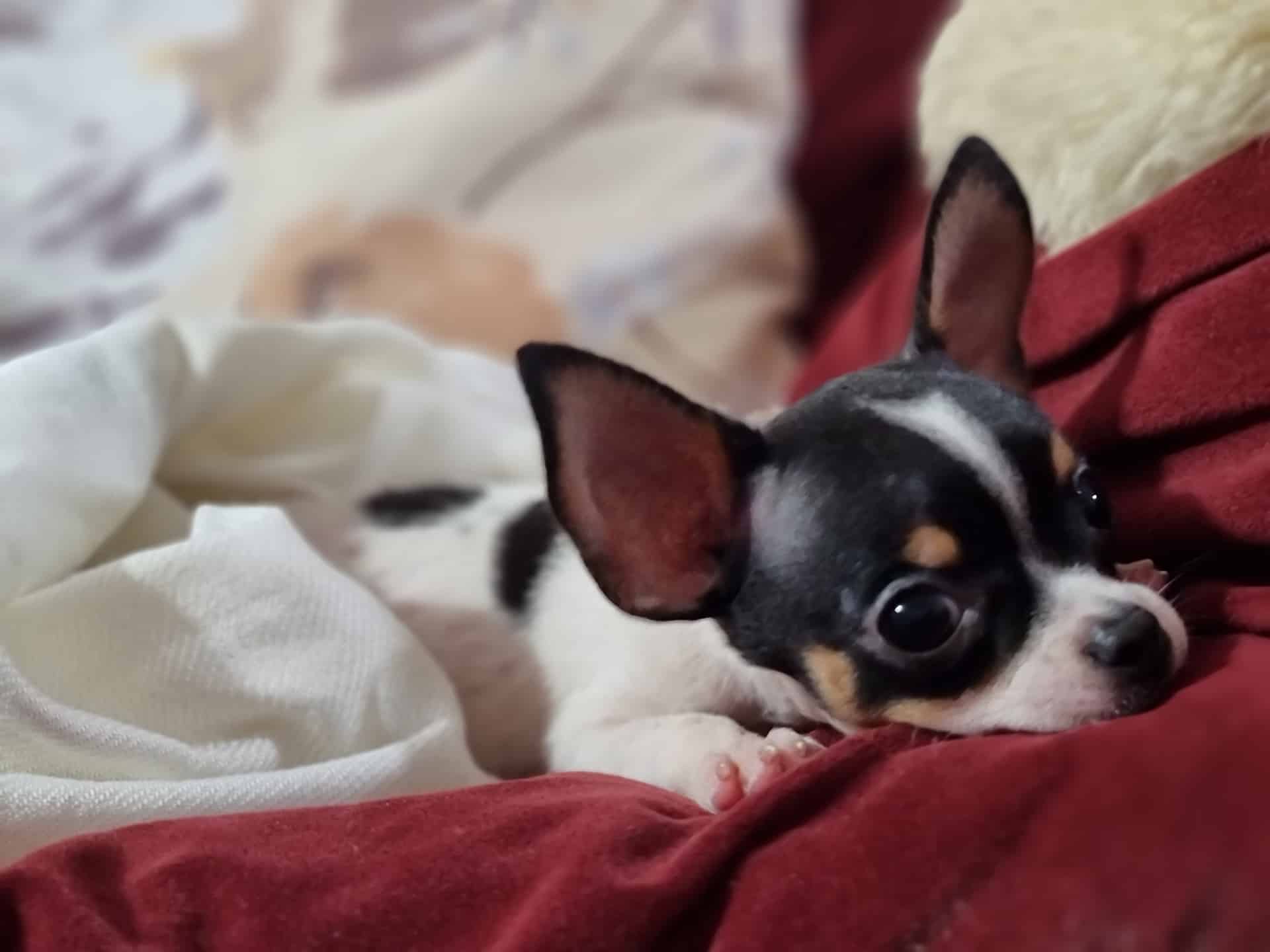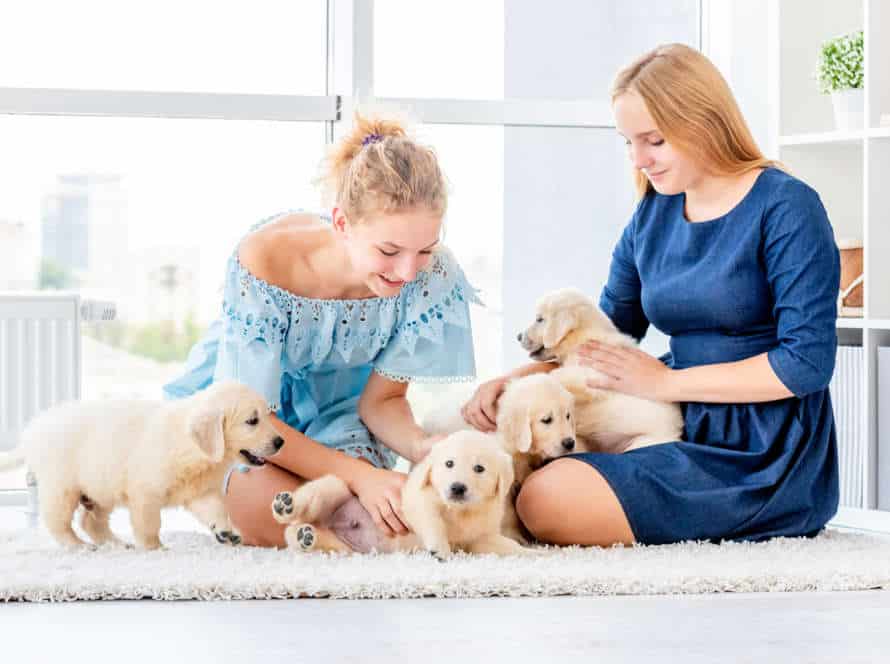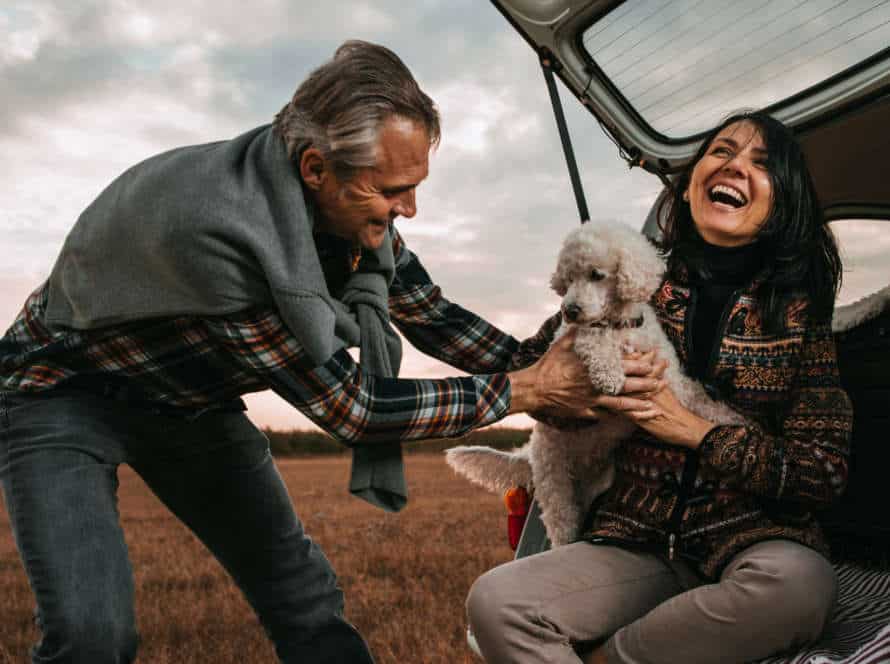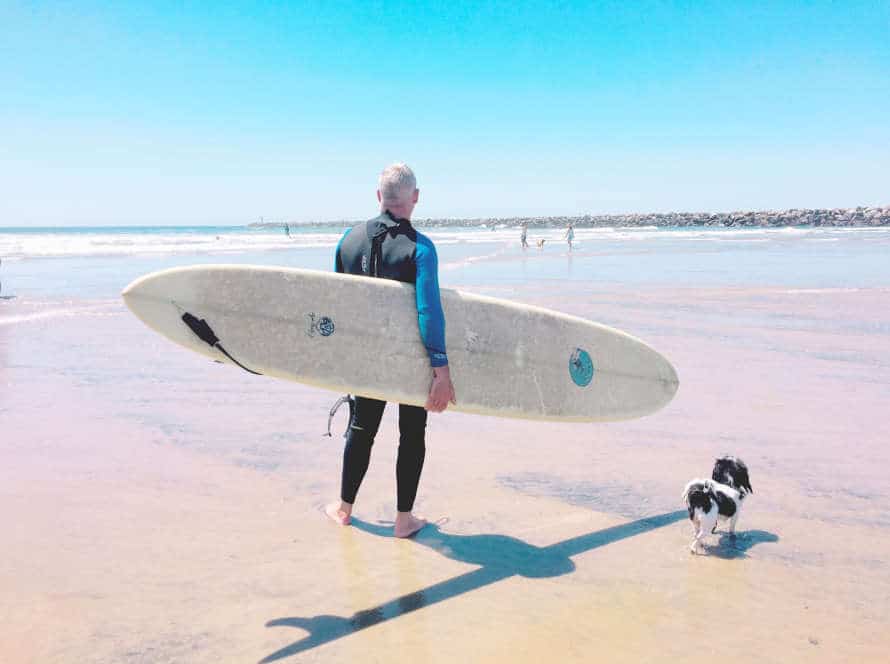Building Confidence in Timid Puppies: A Step-by-Step Guide
Building trust in timid puppies can take time and be tricky. But it is necessary to help your pup become a content and balanced dog. Here is how you can do it:
- Start with fundamental socialization tasks.
- Give a secure and serene environment for your pup.
- Make positive connections with fresh encounters.
- Use positive reinforcement training methods to motivate good behavior.
- Progressively introduce your puppy to novel and demanding situations.
- Have persistence and patience to up your pup’s trust over time.
Keep in mind that each pup is special, and some may need more energy and effort to win over their shyness. But with resolution, patience, and lots of love, you can help your scared pup become a confident and happy adult dog.
Pro Tip: Take the help of a dog trainer if you require extra advice or support in building your puppy’s confidence.
Understanding the Causes of Timidity in Puppies
Timid pups may be scared or anxious. They might seem distant or shy around humans or other animals. It’s good to recognize what makes them afraid before trying to make them more confident. Causes of puppy fear can be genetic or environmental. Knowing why the pup is scared will help you find the best solution.
Genetic Predisposition
Genetic predisposition can be a factor in timidity in puppies. Certain breeds have a genetic predisposition to being more anxious or fearful, which can lead to shyness.
Yet, genetics is just one factor that affects a puppy’s behavior. Environmental factors like early socialization and positive reinforcement training can have a huge effect on a puppy’s temperament.
A great way to build confidence in timid puppies is to expose them gradually to new people, animals, and environments by using positive reinforcement training. This can be done through rewards like treats or toys. Increase the difficulty of the training as the puppy gets more confident.
Also, provide a safe and comfortable environment with plenty of socialization chances and a consistent routine to make them feel safe.
Pro tip: If you’re worried about your puppy’s behavior, seek help from a professional dog trainer or behaviorist to create a tailored training plan.
Lack of Socialization
Timidity in puppies is often caused by a lack of socialization. Pups that don’t interact with other dogs, people and new surroundings between 3-14 weeks may become scared of anything unknown.
To build confidence in timid puppies, start socializing them early with puppy classes, dog parks and regular walks in safe places. Employ positive reinforcement techniques like treats, praise and play to foster trust. Slowly introduce your pup to different items, noises and people in a controlled environment to help them with new scenarios. Be persistent and consistent in training and don’t scold them for being fearful. If you need extra help, reach out to a qualified trainer or behaviorist.
Traumatic Experiences
Timidity in puppies is often caused by traumatic experiences. These can be physical abuse, separation anxiety, loud noises, or unknown places. To help build confidence in a timid pup, here are some tips:
- Create a calm and secure setting.
- Incentivize good behaviour with rewards and praise.
- Expose your puppy gradually to new things like people, other dogs, and varied surroundings.
- Make sure they socialize with friendly dogs and humans.
- Be patient and don’t scold them for being scared.
With regular training and time, your pup will overcome their timidity and become confident.
Creating a Safe and Secure Environment
Ensure a secure space for your puppy. Start in its own area and steadily expand to the whole house. Guide it with boundaries and teach it how to behave. Follow this step-by-step to help your pup build confidence. It will learn safely and progress gradually.
Designing a Comfortable Living Space
Designing a Comfortable Living Space
The heading “Designing a Comfortable Living Space” hints at creating an atmosphere that looks and feels great. Follow these tips:
- Focus on functionality and practicality when picking furniture.
- Pick a color palette that fits your vibe.
- Let natural light and ventilation in for a healthy space.
- Maximize storage to decrease mess.
- Add indoor plants or natural elements like wood or stone for a soothing feel.
For anxious puppies, here are some extra tips:
- Create a secure spot like a bed or crate for your pup.
- Use positive reinforcement to build confidence.
- Expose your pup to new sights, smells, and sounds gradually.
- Provide exercise and socialization.
- Patience and consistency are key to building confidence.
Pro Tip: When designing, factor in your pet’s needs like pet-friendly flooring or a feeding station.
Avoiding Loud Noises and Sudden Movements
To help your timid pup gain confidence, reduce loud noises and sudden movements. Vacuum cleaners and doorbells can be too overwhelming for fearful and anxious puppies. Here are some tips to build a peaceful atmosphere for your pup:
- Try to keep noise levels low.
- Introduce unfamiliar sounds and experiences with rewards.
- Be mindful of your body language and movements.
- Give your pup a safe space to feel more comfortable.
By following these steps, your pup can adjust to its environment and become more confident!
Providing Consistent Routines and Positive Reinforcement
Timid puppies need consistent routines and positive reinforcement to build their confidence and create a safe environment. Here are some tips:
- Set up a daily routine: feed them, potty breaks, playtime, training, and sleep.
- Use positive reinforcement training such as clicker training and treats to learn new skills.
- Socialize with other dogs and people. Supervised playdates and regular outings help to boost confidence and ease anxiety.
- Never punish or yell – this increases fearfulness. Use positive reinforcement and encouragement instead.
- Building confidence takes time and patience. Consistent routines and positive reinforcement will help your puppy become more secure.
Encouraging Socialization with People and Other Animals
Socialization is key to building confidence in shy puppies. Spend time with people and animals that your pup can trust and like. This will create a positive environment that will help boost your pet’s self-assurance. Here’s a step-by-step guide on how to socialize timid puppies!
Gradual Introductions to New People
Introducing timid puppies to new people gradually is vital for building confidence. Here are steps to do this:
- Find a quiet place with few distractions.
- Begin with one person who is calm and patient.
- Have them speak softly and not look directly at the puppy.
- Let the puppy approach the person on their own and provide a treat or toy as positive reinforcement.
- As confidence grows, increase the number of people and distractions. Do this process with other animals too.
Consistency is key for socializing puppies. Gradual introductions lead to positive experiences, which help boost confidence and reduce fear-based behaviors in the long term.
Socialization with Other Dogs
Socializing your pup with other pooches can be a great and fulfilling experience! It’s essential to introduce your doggo to other doggos slowly and cautiously for their safety. Here are some tips for socializing your pooch with other doggos:
- Start small. Introduce your pup to one or two other doggos at a time.
- Pick the right place. Start in a neutral area like a park or a different backyard. Stick to comfortable zones.
- Use a leash. Keep your pup on a leash at first and supervise their playtime. Gradually move away as you feel safe.
- Watch body language. Carefully notice your pup’s body language during interactions. If they seem anxious, separate them.
- Reward good behavior. Praise and motivate them to interact and give treats for good behavior.
Remember, always introduce your pup to other doggos gradually and carefully. Socializing is a significant part of their growth, so be patient while helping them become more confident and adjusted.
Pro Tip: If your pup is timid or uneasy, work with them alone with a reliable trainer to start their journey towards socialization.
Positive Reinforcement for Social Behavior
Positive reinforcement is a great way to help shy or timid puppies become social. Dogs, just like people, love rewards and will often repeat behaviors that earn them something good. To build confidence in puppies, try these steps:
- Begin by introducing them to only one person or dog at a time.
- Use treats, toys or other rewards to reward positive interactions.
- As the pup gains confidence, gradually increase the duration and complexity of the interactions.
- Keep an eye on their body language and intervene if they’re feeling stressed or uncomfortable.
- Practice consistently to help your puppy learn social skills and reinforce positive behaviors.
With patience and persistence, your pup will learn to love socializing and be a great companion.
Training Exercises to Build Confidence
Gaining self-assurance in bashful pups needs plenty of patience and stability. Here’s a step-by-step guide on how to use training exercises and positive reinforcement to aid them. We’ll discuss a few exercises that can help your pup feel more at ease in their surroundings and not be as scared of strangers and new experiences.
We’ll discuss the following training exercises and techniques:
- Socialization – Introducing your pup to new situations, pets and people.
- Obedience Training – Teaching your dog basic commands such as sit, stay, come, and heel.
- Positive Reinforcement – Praising and rewarding the dog for good behavior.
- Desensitization – Gradually exposing the pup to triggers that make them anxious in a safe and controlled environment.
Basic Obedience Commands
Teaching your pup basic obedience commands is a great way to communicate and keep them safe. Here are the 3 must-knows:
- Sit: Start with this one. Hold a treat up high. As their head follows it, move your hand back and say “sit.” Gently push their hindquarters down.
- Stay: Have them sit first. Level your hand with their face, say “stay” and step in front of them. Begin with only 3-4 seconds, then gradually increase.
- Come: Use a long enough rope. Call their name and say “come.” Reward with treats when they come.
Positive reinforcement with treats, praise and love is key to build their confidence.
Confidence-Building Exercises (e.g., Agility Training, Trick Training)
Confidence-building exercises such as agility training and trick training can help dogs boost their confidence and face their fears. Here are some that can help timid puppies:
- Gradual exposure: Start with less scary things and environments. Increase the level of exposure slowly.
- Positive reinforcement: Give treats, praise, and toys when your pup behaves well.
- Trick training: Teach tricks to make them more comfortable.
- Agility training: Help them navigate obstacles. This builds physical and mental strength.
- Socialization: Develop social skills and build confidence around dogs and people.
Do these exercises gradually. Patience is key as it takes time to build confidence. Pro Tip: Consistency and praise are musts to help a pup effectively.
Playtime and Exercise for Mental and Physical Stimulation
It is essential for your pup’s physical and mental growth to play and exercise regularly. This also helps build their self-assurance and social skills. To aid timid puppies, here’s a step-by-step guide to training exercises:
- Begin with basic commands to form trust and obedience with your puppy.
- Introduce your pup to new surroundings, sounds, and objects through desensitization methods.
- Teach fun activities like roll-overs, high-fives, or fetch to boost their self-esteem and participation with you.
- Utilize positive reinforcement techniques like treats and praise to reward their progress and accomplishments.
- Include playtime as a daily practice to enhance your bond and your puppy’s assurance.
- Be patient and steady in your training, and celebrate your pup’s triumphs. Pro tip: Make training and exercising amusing and captivating for your puppy by including toys and various atmospheres.
Seeking Professional Assistance if Needed
If progress with showing your pup your home is safe has been slow, think about getting help! A reputable trainer or behaviorist can help with fears and shyness. Knowing when to do it yourself or get help is essential.
Consulting a Veterinarian to Rule Out Medical Issues
Have a timid pup? Consult a vet to rule out medical issues that could be causing shyness. A vet can check for underlying health worries that could be linked to fearful behavior.
Your vet can provide advice on how best to work with your timid pup. They may recommend desensitization and counterconditioning techniques.
Be patient with your pet. Building confidence in timid puppies takes time, consistency, and love. Celebrate successes, no matter how small. Every pup is unique. Progress can happen at different rates.
Working with a Dog Trainer or Behaviorist
Struggling to train your pooch? Experiencing unwanted behaviors? It’s time to get help from a dog trainer or behaviorist! These experts can give you the knowledge and experience to get you and your pup’s issues sorted out. Here’s what to know:
- Find a trainer/behaviorist with the right qualifications, like certifications from a reputable organization, or experience with similar issues.
- Work closely with the trainer/behaviorist, following their advice and plan.
- Don’t expect quick results – training and behavior change take time and patience.
- Be open to new techniques and approaches to training and behavior.
- Remember the goal: to build a stronger bond between you and your pup. A well-trained, happy pup is a joy to have!
Consideration of Medication Options if Recommended by a Veterinary Professional
If your pup is timid, expert help is essential. A vet can recommend medication to ease their anxiety. Consider these options:
- Anti-anxiety meds – they change brain chemicals.
- Antidepressants – these regulate brain neurotransmitters, reducing stress.
- Sedatives – calming them during grooming, car rides, etc.
Remember: only a vet should give meds, and monitor the dosage to avoid side effects.
Pro tip: Positive reinforcement and training is key to build confidence and make them more comfortable.
Frequently Asked Questions
1. How long will it take to build confidence in a timid puppy?
Building confidence in a timid puppy is a gradual process that takes time and patience. It can take a few weeks to several months before you begin to see noticeable improvements in your puppy’s confidence.
2. What are some signs that my puppy is timid or lacks confidence?
Some signs that your puppy may be timid or lacking in confidence include cowering, hiding, or trembling in new or unfamiliar situations, being easily startled or frightened, excessive barking or whining, and reluctance to explore or play.
3. How can I help my timid puppy build confidence?
There are several ways you can help your timid puppy build confidence, including providing a safe and comfortable environment, introducing new experiences gradually, using positive reinforcement training techniques, and giving plenty of praise and encouragement.
4. Should I expose my timid puppy to challenging situations to help build confidence?
While it’s important to gradually expose your puppy to new experiences, it’s also important to avoid overwhelming them with overly challenging situations. Instead, start with small, manageable steps and gradually progress as your puppy becomes more confident.
5. Can socialization help my timid puppy build confidence?
Socialization can be helpful in building confidence in timid puppies, as it allows them to interact with other dogs and people in a safe and controlled environment. However, it’s important to proceed slowly and carefully, and to always monitor your puppy’s reactions to new experiences.
6. When should I seek professional help for my timid puppy?
If your puppy’s timidity is severe or persistent, or if you’re having difficulty making progress in building their confidence, it may be time to seek professional help. A qualified veterinarian or dog behaviorist can help diagnose and treat any underlying issues that may be contributing to your puppy’s timidity.







